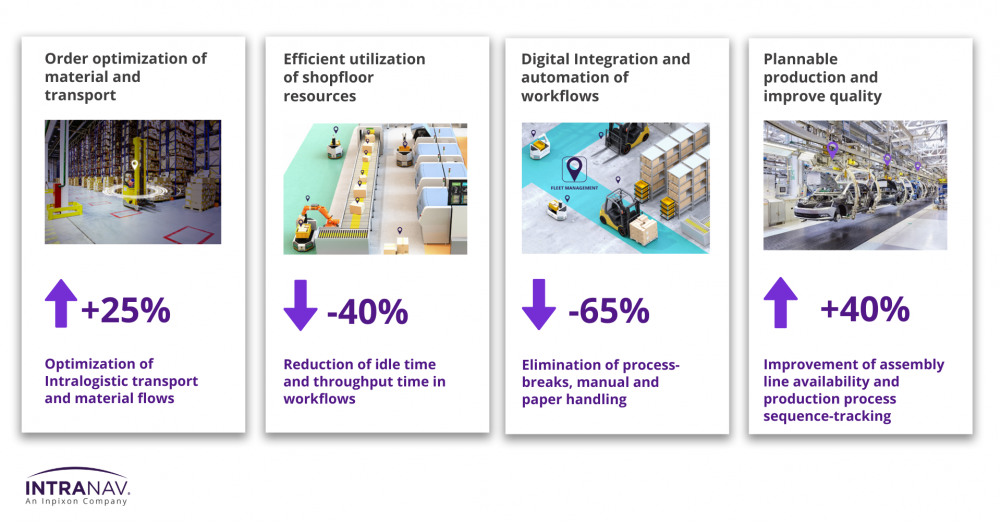When bringing industry 4.0 to your facilities, it's important to explore multiple aspects of these projects, including planning, cost and implementation, in order to make sure they are successful. Here are five important points to consider when building industry 4.0 digitization initiatives for your organization.
1. Change Management & Growth Through Change
Employees should be made aware of the fact that personnel can be better used in overarching task areas than for partial tasks. Real-time location (RTLS) and the Industrial Internet of Things (IIoT) helps to eliminate the need to manually perform these partial tasks such as material identification processes or the systemic input of production and process data. Correspondingly, more extensive fields of activity open up for employees, which leads to a much higher level of motivation, since employees evaluate their work as meaningful and value-adding.
2. Evaluating Digitization Concepts
In most medium to large companies, resources are available for assembling smart factory or warehouse teams. These often consist of a mix of senior-experienced employees. Possible concepts are evaluated and tested for the first time. It's important to follow the approach of automating or optimizing functioning and established processes with the help of digitization. Automating a process or workflow that is not running smoothly will not help in making the process better.
This was also the case with our customer Kramer-Werke. In our podcast, the person responsible for the smart factory area goes into the essential steps, from planning to rollout, that are necessary for the digitization of wheel loader production.
3. Budget and Return on Investment (ROI)
For innovative solutions such as INTRANAV, an Inpixon company's Virtual Warehouse and Smart Factory, which contribute to process optimization and use holistic approaches, a case-specific budget must be cleared. Therefore, the first thing to do is to categorize the discovered potential in the first step of the research in order to sort it according to priorities. The top potential is evaluated accordingly and, in addition to the allocated budget, internal project resources for implementation, project management and change management must be requested. Always keep the quote from Professor Dr. Markus Haid, that "Digital steps are minimal steps," in mind. It points to the problem that companies often try to digitize too much at once. The most successful strategy here is to roll out the solution step by step – across multiple processes and locations.
Once implemented, however, impressive KPIs such as up to 40% reduction in idle and lead times in workflows or up to 65% elimination of process disruptions, as well as manual and paper handling, can be achieved quickly.

4. Define Project Goals
When setting project goals, it helps to ask yourself relevant questions in advance. We would be happy to provide a brief explanation based on a simple use case example:
What Are Our Pain Points in Inventory Management in the Warehouse?
- Long search times when finding inventory, which slows down the overall process
- System maintenance and inventory management as a manual process was identified as a "time waster"
What Exactly Do We Want to Achieve?
- "We want to implement a cost-effective and cross-site equipment and inventory management system"
Which Processes Should be Optimized in the Inventory Warehouse?
- The model archiving and model recording system should help to find models in the inventory quickly and specifically and to enter new models into the system without wasting time
- Mapping of the inventory - real-time overview of where the inventory is actually located
- Inventory history, alerts and reminders: We want to understand where the inventory was moved, who took it, and how high the actual standing times and storage location capacities are
- Inventory must be recognized in the existing warehouses and at the same time be able to be assigned in the database
Find out how an international automobile and motorcycle manufacturer optimized its inventory handling.
5. Speak to Partners and Consultants on Testing Processes
After the problem and the path to the solution have been evaluated, after an exchange with digitization experts such as INTRANAV, an Inpixon company, or our partners MHP, the management and IT consulting subsidiary of Porsche or umlaut - part of Accenture, appropriate solutions are selected that are based on modern, investment-safe technologies are based.
For small to highly complex projects there are different solutions with modern WMS/ERP, real-time location, RTLS, AutoID, automated vehicles for small to highly complex projects there are different solutions with modern WMS / ERP, real-time location, RTLS, AutoID, automated vehicles without drivers drive (so-called AGVs from e.g. Agilox), automated small parts warehouse (AKL) and much more.
However, an important step before implementation is testing. A test field must be made available for this, such as a sandbox for ECOM and test products in the warehouse/at the supplier and 3PL. The projects can be tested on a small scale for functionality and then rolled out over a large area after quality testing.
Learn more about the optimization of transport and material flows through digital end-to-end products from INTRANAV, an Inpixon company.


-3.png?length=1000&name=Inpixon%20LinkedIn%20Banner%20August%202025%20(2)-3.png)

